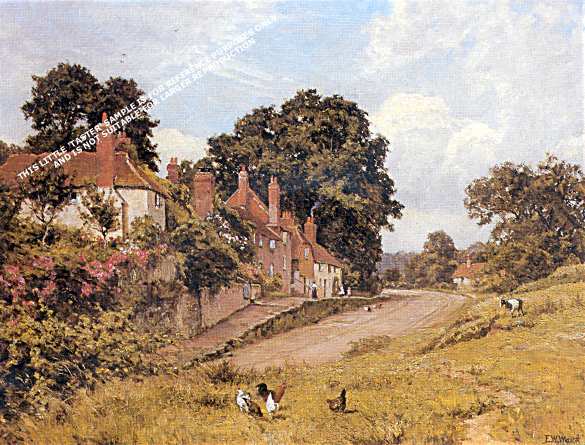|
228
'THE TERRACE AT FITTLEWORTH'
by E. Wilkins Waite (1854-1924)
 Fittleworth
lies approximately midway between Petworth and Pulbrough in
deepest Sussex. Those who visit Arundel Castle and Roman Bignor,
will make a point of routing their journey through this tiny,
almost untouched and engaging village. Fittleworth
lies approximately midway between Petworth and Pulbrough in
deepest Sussex. Those who visit Arundel Castle and Roman Bignor,
will make a point of routing their journey through this tiny,
almost untouched and engaging village.
 A
valuable detour, this is one of many which show the beauty
of the southern county that boasts tranquillity even today.
Recognised for its climatic benefits, and protected from the
ravages of bad weather along the English Channel by the high
contours of the South Downs, English kings as well as Roman
dignitaries have held this part of England with much affection. A
valuable detour, this is one of many which show the beauty
of the southern county that boasts tranquillity even today.
Recognised for its climatic benefits, and protected from the
ravages of bad weather along the English Channel by the high
contours of the South Downs, English kings as well as Roman
dignitaries have held this part of England with much affection.
 The
climate of the local region encourages the finest flowers
to bloom into profusion, and even vines bore grapes fomented
into palatable wines for Roman husbandry. The heady Victorian
days when this prolific artist lived and worked, offered the
real beauty of peace in the rural countryside. There were
no machines here. Even the local steam railway found it uneconomic
to include Fittleworth as an important halt. The
climate of the local region encourages the finest flowers
to bloom into profusion, and even vines bore grapes fomented
into palatable wines for Roman husbandry. The heady Victorian
days when this prolific artist lived and worked, offered the
real beauty of peace in the rural countryside. There were
no machines here. Even the local steam railway found it uneconomic
to include Fittleworth as an important halt.
 Perhaps
peace was less valued than it is today because work was so
hard. Individuals endured long working hours seven days a
week. Hardship was common and deep Winter's cold ensured life-span
to be far shorter than today. Perhaps
peace was less valued than it is today because work was so
hard. Individuals endured long working hours seven days a
week. Hardship was common and deep Winter's cold ensured life-span
to be far shorter than today.
 Historically,
the village name claims a very interesting origin in etimological
terms. Annually selected players would recreate 'King George
and the Dragon', the so-called Fittleworth Play. 'Fytte' or
'fitt' is the division of a song or Ballad. Though occasionally
performed between the two wars, the ballad was an annual event
until 1914. Garishley costumed 'Mummers' or 'Tipteers' (Tippled
Quoits players?) performed parts of this rather obscure re-creation
of their unique Christmas-time pantomime sketch. The Tipteers
would travel the surrounding villages visiting door-to-door,
politely requesting a performance before family audiences.
The net result from receiving the reward of a few pence and
a drink in each home was inevitable! Historically,
the village name claims a very interesting origin in etimological
terms. Annually selected players would recreate 'King George
and the Dragon', the so-called Fittleworth Play. 'Fytte' or
'fitt' is the division of a song or Ballad. Though occasionally
performed between the two wars, the ballad was an annual event
until 1914. Garishley costumed 'Mummers' or 'Tipteers' (Tippled
Quoits players?) performed parts of this rather obscure re-creation
of their unique Christmas-time pantomime sketch. The Tipteers
would travel the surrounding villages visiting door-to-door,
politely requesting a performance before family audiences.
The net result from receiving the reward of a few pence and
a drink in each home was inevitable!
 Edward
Wilkins Waite was a prolific landscape painter who lived just
outside Blackheath, and later at Reigate and Dorking. He was
a member of the New Watercolour Society and exhibited at the
Royal Academy from 1878. His picture titles include 'The Daisy
Field, Fittleworth', 'The Pineapple Inn', 'Boxhill Bridge',
'Hatch Farm', 'Silent Highway', 'The Water Mill' and 'Autumn
at the Mill' amongst many others. Edward
Wilkins Waite was a prolific landscape painter who lived just
outside Blackheath, and later at Reigate and Dorking. He was
a member of the New Watercolour Society and exhibited at the
Royal Academy from 1878. His picture titles include 'The Daisy
Field, Fittleworth', 'The Pineapple Inn', 'Boxhill Bridge',
'Hatch Farm', 'Silent Highway', 'The Water Mill' and 'Autumn
at the Mill' amongst many others.

|
